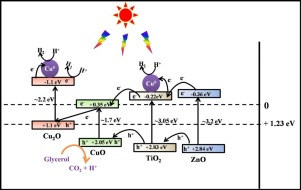Applied Catalysis A: General ( IF 5.5 ) Pub Date : 2018-01-09 , DOI: 10.1016/j.apcata.2018.01.009 N. Subha , M. Mahalakshmi , M. Myilsamy , B. Neppolian , V. Murugesan

|
The low-cost and scalable Cu and Zn doped TiO2 (CuZn-TiO2) photocatalyst was synthesized by simple hydrothermal method. The heterojunction formed by ZnO, CuO, Cu0 and Cu2O with TiO2 in 0.5 wt% CuZn-TiO2 photocatalyst effectively suppressed the electron-hole (e−-h+) recombination and enhanced the charge transfer efficiency of TiO2. The heterojunctions formed between metal oxides in nanocomposite material were confirmed from the overlapped lattice fringes in TEM images. XPS confirmed the presence of Ti4+, Zn2+, Cu2+, Cu+1 and Cu0 in 0.5 wt% CuZn-TiO2. In DRS-UV–vis spectra, co-doping of Zn and Cu showed an appreciable red shift for 0.5 wt% CuZn-TiO2 due to the formation of impurity energy levels by heterojunctions between semiconductors (S-S) like TiO2, ZnO, CuO and Cu2O and also between semiconductors - metallic Cu metal (S-M). Additionally, 0.5 wt% Cu-TiO2 showed greater red shift than 0.5 wt% Zn-TiO2, this revealed the contribution of Cu doping in the effective utilization of solar light. PL spectra clearly revealed the role of ZnO, Cu2O, CuO and Cu0 on suppressing the e−-h+ recombination of TiO2. The mesoporous nature of 0.5 wt% CuZn-TiO2 was confirmed from the N2 adsorption-desorption study. For the first time, direct Z-scheme along with heterojunction double charge transfer mechanism were proposed for the better performances of CuZn-TiO2 nanocomposite. Among the synthesized materials 0.5 wt% CuZn-TiO2 showed 3.5 fold time improved H2 production than TiO2 due to effective e−-h+ separation at S-S and S-M heterojunctions and the better utilization of visible light in the solar spectrum.
中文翻译:

直接Z方案异质结纳米复合材料可增强太阳能H 2的产生
通过简单的水热法合成了低成本,可扩展的Cu和Zn掺杂的TiO 2(CuZn-TiO 2)光催化剂。ZnO,CuO,Cu 0和Cu 2 O与TiO 2在0.5 wt%的CuZn-TiO 2光催化剂中形成的异质结有效地抑制了电子-空穴(e -- h +)的复合并提高了TiO 2的电荷转移效率。从TEM图像中重叠的晶格条纹确认了纳米复合材料中金属氧化物之间形成的异质结。XPS证实存在Ti 4+,Zn 2 +,Cu 2 +,Cu0.5重量%的CuZn-TiO 2中的+1和Cu 0。在DRS-UV-vis光谱中,Zn和Cu的共掺杂显示0.5 wt%CuZn-TiO 2有明显的红移,这是由于半导体(SS)如TiO 2,ZnO,CuO之间的异质结形成了杂质能级和Cu 2 O,以及半导体之间-金属Cu金属(SM)。另外,0.5重量%的Cu-TiO 2显示出比0.5重量%的Zn-TiO 2更大的红移,这表明Cu掺杂在有效利用太阳光中的贡献。PL光谱清楚地表明ZnO,Cu 2 O,CuO和Cu 0在抑制e -- h方面的作用+ TiO 2的复合。从N 2吸附-脱附研究证实了0.5wt%的CuZn-TiO 2的介孔性质。首次提出直接Z方案以及异质结双电荷转移机制,以提高CuZn-TiO 2纳米复合材料的性能。在合成的材料中,由于在SS和SM异质结处有效的e -- h +分离以及太阳光谱中可见光的更好利用,0.5 wt%的CuZn-TiO 2的H 2生成量比TiO 2提高了3.5倍。


























 京公网安备 11010802027423号
京公网安备 11010802027423号